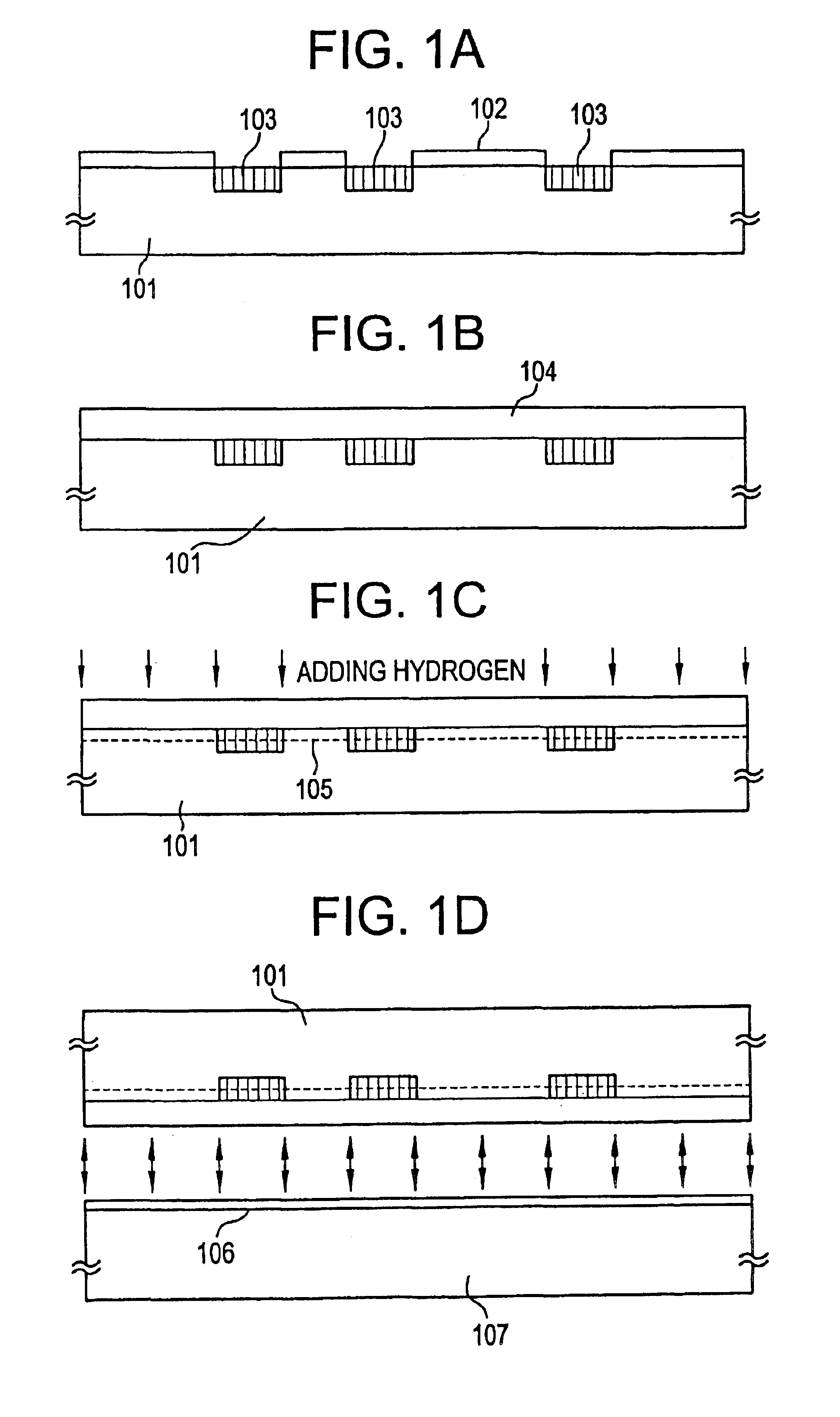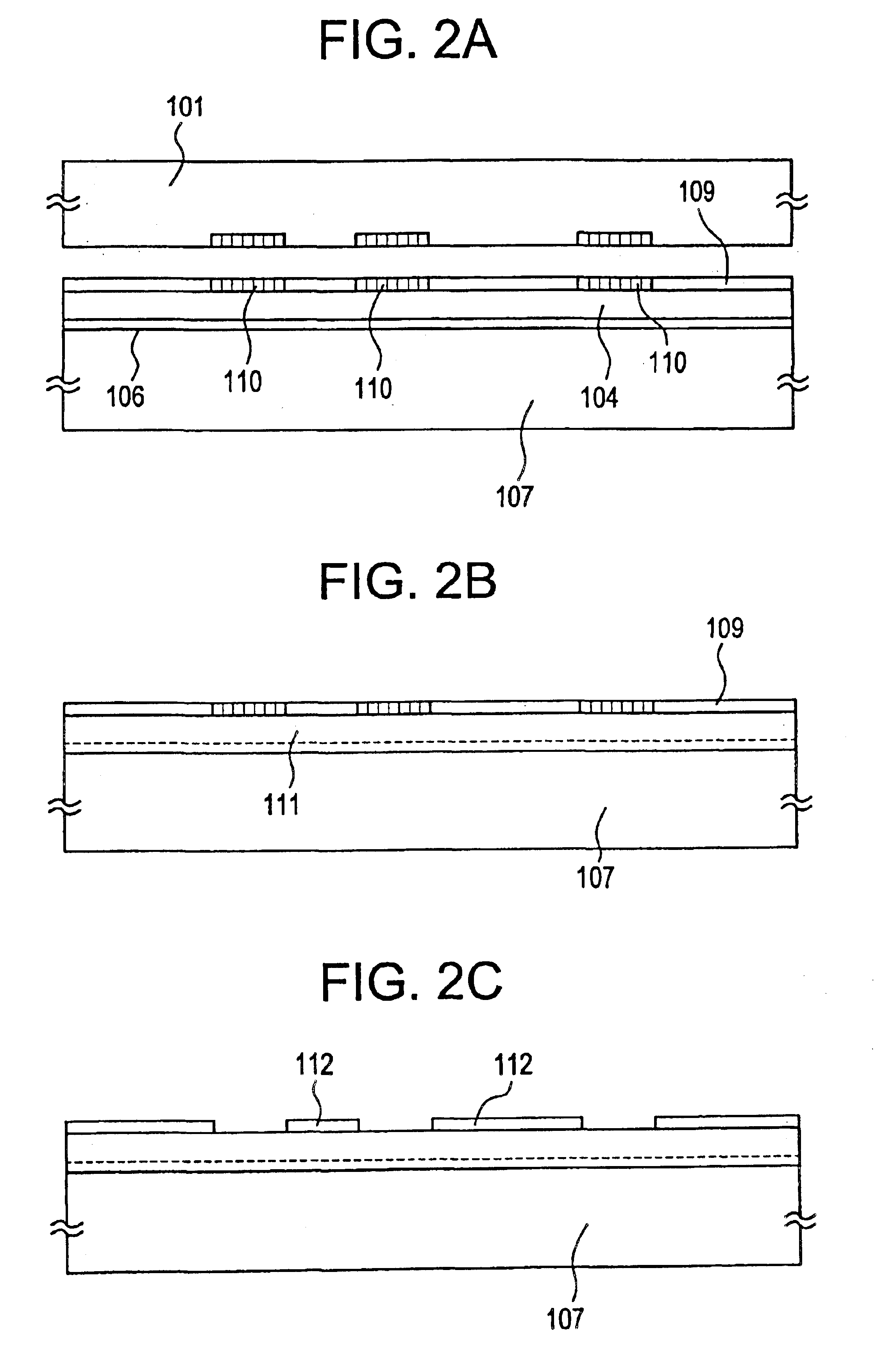Process for production of SOI substrate and process for production of semiconductor device
a technology of soi substrate and semiconductor device, which is applied in the direction of semiconductor devices, radio frequency controlled devices, electrical devices, etc., can solve the problems of single-crystal silicon thin film cracking and peeling at the edges of silicon substrate, stress to occur,
- Summary
- Abstract
- Description
- Claims
- Application Information
AI Technical Summary
Benefits of technology
Problems solved by technology
Method used
Image
Examples
example 1
The process of the invention is explained with reference to FIGS. 1A to 1D and FIGS. 2A to 2C. First, a single-crystal silicon substrate 101 is made available. On its principal surface (on which elements are to be formed) is formed an insulating film, 50 nm thick, (which is a silicon oxide film in this example). The silicon oxide film is patterned to selectively form a mask 102. The silicon oxide film may be replaced by any other insulating film, such as silicon nitride film, silicon oxynitride film, and resist mask.
The mask 102 should cover the part which becomes the active layer of TFT afterward. Also the portion covered by the mask 102 may be used for thin film of single-crystal silicon.
The principal surface of the single-crystal silicon substrate 101 undergoes anodizing treatment, so that a portion of the single-crystal silicon substrate 101 (the exposed region without the mask 102) is converted into a porous silicon layer 103. This anodizing treatment may be carried out in a mi...
example 2
This example demonstrates, with reference to FIG. 3, the fabrication of TFT on the single-crystal silicon layer (in an island shape) which was formed by the process in Example 1.
First, the single-crystal silicon layer (in an island shape) is formed according to the process of Example 1. It is covered with a gate insulating film 302 of silicon oxide (120 nm thick) by plasma CVD. Then, a gate electrode 303 of n-type polysilicon is formed. See FIG. 3A.
Doping is performed to impart the n-type or p-type by the self-alignment process which employs the gate electrodes 303 as a mask. (In this example to fabricate n-type TFTs, the dopant is phosphorus. For p-type TFTs, the dopant is boron.) This step forms the impurity region 304. See FIG. 3B.
That part of the silicon layer which is just under the gate electrode may be doped with an impurity for reverse conductivity type (for example, boron in the case of n-type TFT) so as to control the threshold value of TFT. This doping may be accomplished...
example 3
This example demonstrates a liquid crystal display unit (FIG. 4) with TFT semiconductor circuits fabricated by the process in Example 2. The pixel TFT (or pixel switching element) and the cell assembly may be produced by any known method; therefore, their detailed description is omitted.
In FIG. 4, there are shown a supporting substrate (with an insulating surface) 11, a pixel matrix circuit 12, a source driver circuit 13, a gate driver circuit 14, a counter substrate 15, a FPC (flexible printed circuit) 16, and a signal processing circuit 17.
The signal processing circuit 17 contains such processing circuits as D / A converter, gamma-correcting circuit, and signal splitting circuit, which used to be formed in an IC. Signal processing may be accomplished by means of an IC chip (with MOSFETs conventionally fabricated on a single-crystal silicon substrate) on the supporting substrate.
Although this example demonstrates a liquid crystal display unit, the present invention may be applied to ...
PUM
| Property | Measurement | Unit |
|---|---|---|
| thick | aaaaa | aaaaa |
| thick | aaaaa | aaaaa |
| thick | aaaaa | aaaaa |
Abstract
Description
Claims
Application Information
 Login to View More
Login to View More - R&D
- Intellectual Property
- Life Sciences
- Materials
- Tech Scout
- Unparalleled Data Quality
- Higher Quality Content
- 60% Fewer Hallucinations
Browse by: Latest US Patents, China's latest patents, Technical Efficacy Thesaurus, Application Domain, Technology Topic, Popular Technical Reports.
© 2025 PatSnap. All rights reserved.Legal|Privacy policy|Modern Slavery Act Transparency Statement|Sitemap|About US| Contact US: help@patsnap.com



